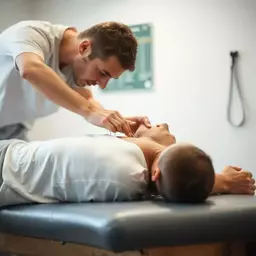Acupuncture Practices Through the Ages

Posted on: 2025-08-18
By: Kaiya Whitmore
In an age where ancient practices meet modern science, acupuncture stands out as a remarkable journey through time. Its roots trace back to early imperial China, where it was not only a treatment method but a philosophy entwined with culture and spirituality. As we delve into the evolution of this practice, we uncover a wealth of knowledge that holds relevance even today.
What You Will Learn
- The origins of acupuncture can be traced back to ancient China during the Zhou, Han, and Tang Dynasties, where it was shaped by philosophical beliefs like Qi.
- Key historical texts, such as the *Huangdi Neijing*, laid the foundational theories and principles of acupuncture, influencing modern practices.
- Acupuncture is grounded in Traditional Chinese Medicine concepts, particularly Qi, meridians, and acupuncture points, which are essential to understanding how it works.
- Traditional techniques like needling, moxibustion, and cupping each serve specific purposes in healing and demonstrate the adaptability of acupuncture over time.
- The Five Elements Theory links natural elements to bodily functions and emotions, aiding acupuncturists in identifying and treating imbalances.
- The balance of Yin and Yang is crucial for health; acupuncturists assess this balance to create targeted treatments that restore harmony.
- Looking forward, acupuncture is merging with technology through innovations like electroacupuncture, laser acupuncture, and tele-acupuncture, enhancing patient experiences.
- As acupuncture finds its place in modern healthcare, it is increasingly recognized for its benefits in pain management and overall wellness.
Innovative Techniques in Modern Acupuncture
Explore the variety of contemporary acupuncture methods that blend tradition with innovation, highlighting their unique benefits.
Electroacupuncture
Combines electrical stimulation with traditional needling to enhance treatment effects.
Laser Acupuncture
Uses low-level lasers instead of needles, offering a non-invasive option for those who are needle-averse.
Tele-acupuncture
Offers online consultations and guidance for at-home treatments, expanding access for patients.
Wearable Technology
Devices track your body’s response to acupuncture, providing real-time data to practitioners.
The Historical Journey of Acupuncture: From Ancient Origins to Modern Practices
Acupuncture is more than just a form of treatment; it's a journey that has traveled through centuries of history! At Acupuncture Perspectives, we recognize the significance of its roots and how they shape the modern practices we see today. As we explore its ancient origins, we can appreciate the cultural richness and evolving techniques that have sustained acupuncture's relevance over time.
Tracing the Ancient Roots of Acupuncture Techniques
Acupuncture in Early Imperial China: Zhou, Han, and Tang Dynasties
Acupuncture's story begins in ancient China, particularly during the Zhou, Han, and Tang Dynasties. Back then, practitioners began documenting their findings, setting the foundation for what would become a comprehensive system of healing. Early texts reveal how acupuncture was intertwined with the philosophical beliefs of the time, such as the concept of Qi, or life energy.
During the Han Dynasty, acupuncture techniques were refined, and practitioners started using specialized tools. The Tang Dynasty further expanded these practices, emphasizing the importance of diagnosis and individual treatment plans. This historical framework is essential in understanding how acupuncture evolved into the holistic practice we cherish today.
Key Texts and Figures: The Influence of Huangdi Neijing and Sun Simiao
Two pivotal figures in the history of acupuncture are the *Huangdi Neijing* (The Yellow Emperor's Inner Classic) and Sun Simiao, known as the "King of Medicine." The *Huangdi Neijing* is a foundational text that outlines theories and principles of acupuncture, focusing on the relationship between the body and nature. It’s like a treasure trove of ancient wisdom!
Sun Simiao, on the other hand, promoted a patient-centered approach, emphasizing the ethical responsibilities of practitioners. His teachings have greatly influenced modern acupuncture, reminding us at Acupuncture Perspectives that the heart of healing lies in the relationships we build with our clients.
Understanding Traditional Chinese Medicine and Acupuncture Practices
Fundamental Concepts: Qi, Meridians, and Acupuncture Points
To grasp acupuncture fully, we need to understand some fundamental concepts of Traditional Chinese Medicine (TCM). *Qi* is the vital energy that flows through our bodies along pathways called meridians. These meridians are crucial in acupuncture, as they connect various acupuncture points that practitioners stimulate to restore balance and health.
In TCM philosophy, health is viewed as a harmonious flow of Qi. When this flow is disrupted, it can lead to illness. Understanding how Qi interacts with the body's meridians is key to appreciating the intricate nature of acupuncture therapy!
Traditional Techniques: Needling, Moxibustion, and Cupping
Acupuncture is known for its needling techniques, but it’s just one of the many methods within TCM. Some other popular techniques include:
- Needling: Inserting thin needles into specific acupuncture points to stimulate healing.
- Moxibustion: Burning dried mugwort near acupuncture points to enhance circulation and promote healing.
- Cupping: Using suction cups to create a vacuum on the skin, promoting blood flow and releasing tension.
Each of these treatments has unique benefits and can be tailored to individual needs, showcasing the adaptability of acupuncture practices throughout history.
Five Elements Theory and its Role in Acupuncture
The Five Elements Theory is another essential aspect of acupuncture, linking natural elements—Wood, Fire, Earth, Metal, and Water—to various bodily functions and emotions. This theory helps acupuncturists understand the unique imbalances within a patient’s body. By tapping into these elements, we can guide the body back to a state of harmony.
At Acupuncture Perspectives, we find the Five Elements Theory a powerful tool in our practice. It not only informs treatment plans but also deepens our understanding of how our environment impacts our health. Isn’t it fascinating how interconnected everything is?
The Balance of Yin and Yang in Acupuncture
Yin and Yang represent the dual nature of life, embodying balance and harmony. In acupuncture, achieving this balance is crucial for overall health. Yin is often associated with qualities like coolness and passivity, while Yang embodies warmth and activity. When one is too dominant, it can lead to health issues.
By assessing a patient’s Yin and Yang balance, acupuncturists can create targeted treatments to promote harmony. This balance is key not just in acupuncture, but in various aspects of life, reminding us of the importance of equilibrium.
Pro Tip
Did you know? Consistency is key when it comes to acupuncture treatments. Regular sessions can maximize the benefits and help maintain balance in your body. Whether you’re addressing chronic pain or seeking overall wellness, consider scheduling regular appointments to fully experience the healing power of acupuncture.
Looking Ahead: The Future of Acupuncture Practices and Techniques
As we gaze into the future of acupuncture, it’s exciting to consider how *tradition meets innovation*. The melding of ancient practices with modern technology is shaping the way we approach acupuncture. With an ever-growing community interested in holistic health, there’s a strong push for treatments that cater to individual needs, using innovative techniques that enhance traditional methods.
One of the most promising developments is the rise of customized acupuncture treatments. Practitioners are beginning to focus more on the unique stories and symptoms of each patient, allowing for a more tailored experience. This approach not only seeks to address specific health concerns but also encourages a deeper connection between practitioners and patients.
Innovations in Acupuncture: Merging Tradition with Technology
We’re witnessing a fascinating shift in how technology is integrated into acupuncture practices. For instance, *digital health tools*—such as apps for tracking symptoms or virtual consultations—are making it easier for patients to engage with their health. These tools offer a convenient way to monitor progress and enhance the overall treatment experience.
Additionally, we’re seeing the emergence of new techniques that utilize technology to augment traditional practices. Here’s a quick list of some of the innovations on the horizon:
- Electroacupuncture: Combines electrical stimulation with traditional needling to enhance treatment effects.
- Laser acupuncture: Uses low-level lasers instead of needles, making it a non-invasive option for those who are needle-averse.
- Tele-acupuncture: Offers online consultations and guidance for at-home treatments, expanding access for patients.
- Wearable technology: Devices that track your body’s response to acupuncture, providing real-time data to practitioners.
Frequently Asked Questions About Acupuncture Practices
As acupuncture continues to evolve, many people have questions about its practices and benefits. Let’s address some of the most common inquiries I encounter in my own practice at *Acupuncture Perspectives*.
What are the most common acupuncture techniques used today?
The landscape of acupuncture is rich with various techniques. Some of the most frequently used methods include:
- Traditional acupuncture: Involves the insertion of fine needles into specific points on the body.
- Cupping therapy: Using suction cups to increase blood flow and relieve pain.
- Moxibustion: Burning mugwort near acupuncture points to provide warmth and healing.
- Auricular acupuncture: Targeting points on the ear to influence various bodily functions.
How has acupuncture been integrated into modern healthcare systems?
Acupuncture has gradually found its place within Western healthcare systems, especially as more practitioners recognize its benefits. Some ways it is being integrated include:
- Pain management programs: Hospitals are incorporating acupuncture as a complementary therapy.
- Wellness centers: Many wellness initiatives now offer acupuncture as part of their holistic approach.
- Insurance coverage: Some insurance plans are starting to recognize acupuncture, making it more accessible to patients.
What are the health benefits of acupuncture for chronic pain?
Research shows that acupuncture can be particularly effective for managing chronic pain. Here are some of the benefits often highlighted:
- Reduced pain: Many patients report significant decreases in pain levels after treatments.
- Improved function: Enhanced mobility and function in affected areas can often be observed.
- Better quality of life: Overall well-being improves as pain decreases, allowing individuals to engage in daily activities more freely.
Summarizing Acupuncture's Evolution and Its Impact Today
Reflecting on the changes and advancements in acupuncture, it’s clear that this ancient practice is not only surviving but thriving in the modern world. The blend of traditional wisdom with innovative techniques holds incredible potential for enhancing well-being. At *Acupuncture Perspectives*, I encourage you to stay curious about these developments as they unfold!
Encouraging Continued Exploration and Engagement with Acupuncture
As we continue to explore the evolving landscape of acupuncture, I invite you to share your own experiences and insights. Have you tried acupuncture? If so, what impact did it have on your life? Engaging in conversations about our journeys fosters community and learning—something I wholeheartedly believe in as we navigate this ancient healing art together!
Recap of Key Points
Here is a quick recap of the important points discussed in the article:
- Historical Foundations: Acupuncture originated in ancient China, with significant developments during the Zhou, Han, and Tang Dynasties, emphasizing diagnosis and individualized treatment.
- Core Concepts: Understanding Qi, meridians, and acupuncture points is essential for grasping the philosophy behind acupuncture and its practices.
- Traditional Techniques: Key methods include needling, moxibustion, and cupping, each offering unique benefits tailored to individual patient needs.
- Five Elements Theory: This theory connects natural elements to bodily functions and emotional states, helping practitioners understand patient imbalances.
- Yin and Yang Balance: Achieving equilibrium between these two forces is crucial for overall health and guides treatment strategies in acupuncture.
- Innovations in Acupuncture: The integration of technology, such as electroacupuncture and tele-acupuncture, is enhancing traditional practices and expanding accessibility.
- Integration into Modern Healthcare: Acupuncture is becoming increasingly recognized within Western healthcare systems for pain management and wellness initiatives.
 What if the key to improved well-being lies in understanding an ancient practice that’s often misu
What if the key to improved well-being lies in understanding an ancient practice that’s often misu
 The integration of acupuncture into modern medicine is not merely a trend; it represents a transform
The integration of acupuncture into modern medicine is not merely a trend; it represents a transform
 Did you know that acupuncture is gaining traction among athletes for its unique ability to not only
Did you know that acupuncture is gaining traction among athletes for its unique ability to not only